




By laura freeMan
When you studied endocrine disorders in medical school, did you get the impression that primary hyperthyroidism was a rare disease you were unlikely to see often—maybe only one or two cases per hundred patients?
Endocrine surgeons have a different message for healthcare providers. There may be more people than we realize who suffer for months or even years without knowing what is really behind their symptoms. Why? No one thought to run two simple labs to detect one of the few devastating diseases that can be completely cured with an outpatient procedure.
“After seeing so many cases, I’m convinced we have a lot more people walking around with hyperparathyroidism than we once suspected. It has so many symptoms that mimic other diseases that unless the right two labs are run and the relationship between their values noticed, the symptoms are likely to look like something else,” UAB endocrine surgeon Jessica Fazendin, MD said.
It’s frustrating for both physicians and patients when prescriptions fails to help. It can undermine the doctor/patient relationship and sow the seeds of doubt.
Not recognizing hyperparathyroidism can also send a whole series of dominos falling, undermining a previously stable condition because problems are attributed to the wrong disease. For example, when a patient’s labs suggest possible
(CONTINUED ON PAGE 3)

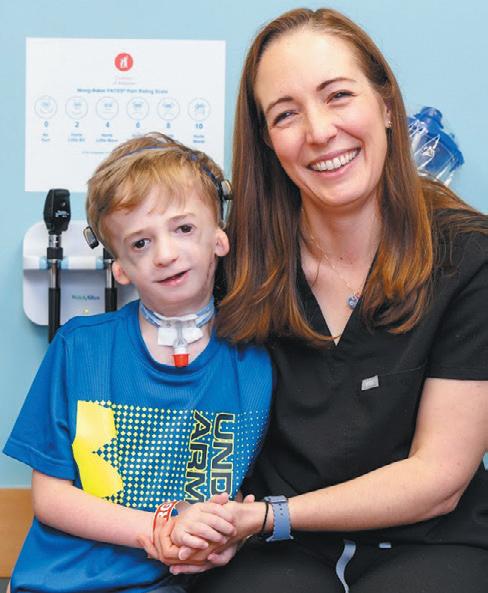



By Jane ehrhardt
“There are kids we meet when they’re sometimes prenatal,” says René P. Myers, MD, a craniofacial and pediatric surgeon. He serves as a plastic surgeon on Children’s of Alabama’s specialized team of providers who treat patients with cleft lip, cleft palate, and other craniofacial disorders.
Recently, the team became one of only 200 approved teams in the U.S. and Canada recognized for meeting the Standards of Team Care for Cleft and Craniofacial Teams, awarded by the American Cleft Palate Craniofacial Association (ACPA). “We are excited about this,” says Cassi Smola, MD, the team’s pediatrician. “We were awarded this because we have all of the team members required and enough of the experience, research, and national expertise to meet their approval.”



















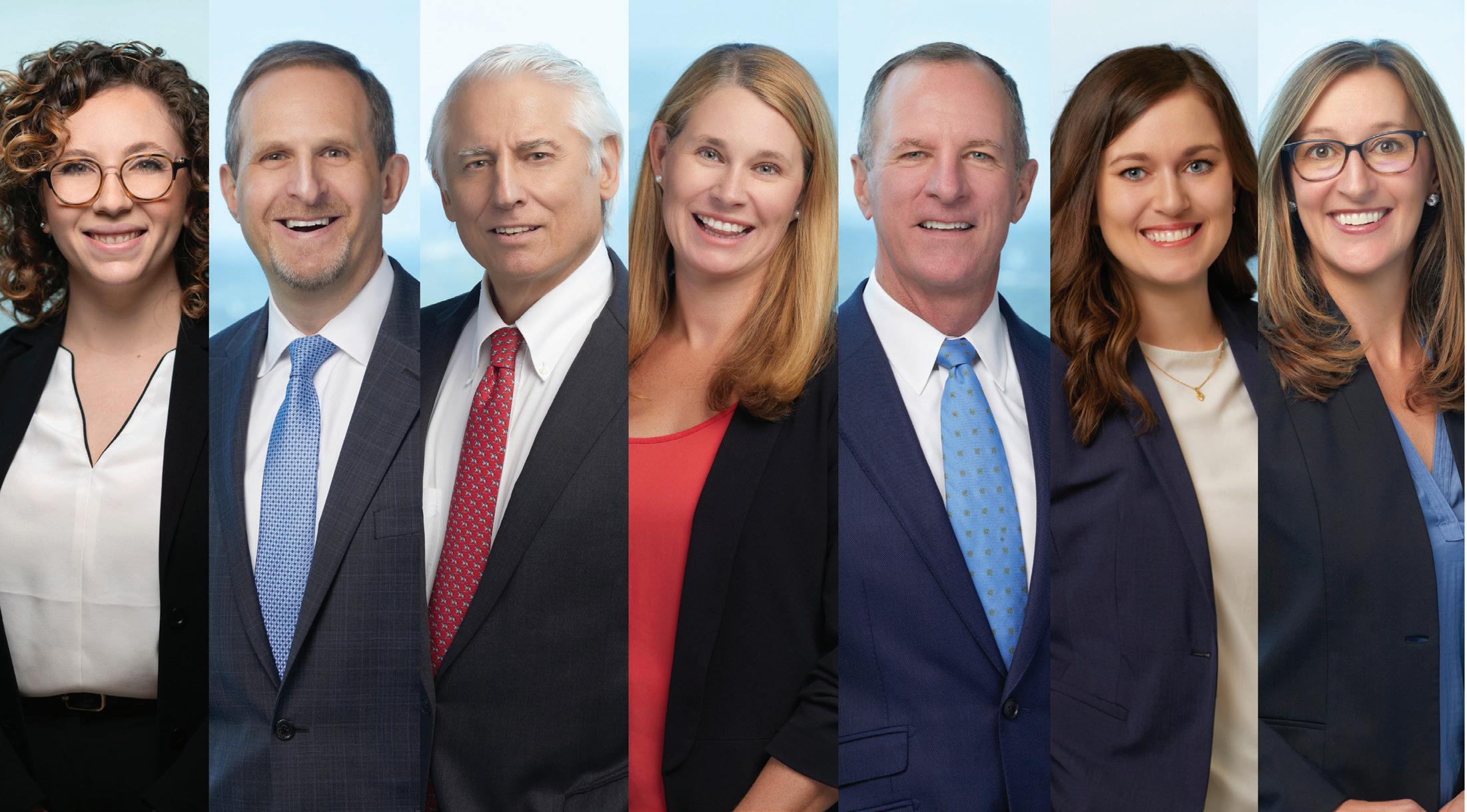
At the heart of one of the most highly regulated industries in the nation, health care facilities and providers face challenges that draw attention and resources away from their mission to provide quality patient care.
Burr & Forman’s health care team works alongside you to address and anticipate your needs by providing preventative guidance and pragmatic solutions, enabling you to focus on providing care and achieving healthy outcomes.
Jessie Bekker
Howard Bogard
Richard Brockman
Kelli Carpenter Fleming
Jim Hoover
Catherine “Cat” Kirkland
Angie Cameron Smith

kidney damage, a physician might discontinue stomach medication which could result in a resurgence of extreme GERD with all the associated complications.
“An endocrinologist can look at the results of these two tests and they usually know with fairly high confidence what is going on,” Fazendin said. “But keep in mind that the disorder can show up in three different combinations. In the classic version, both the calcium and PTH are high. But it is possible for either the calcium or the PTH to look relatively normal. It’s important to consider how those values relate to each other. If calcium levels are low, it should be stimulating PTH to go higher, to release more calcium from the bones. If calcium levels are high, PTH should be falling to slow the release of calcium.”
What are the clues that suggest these two tests should be added to a patient’s labs? Some patients seem to be at greater risk for developing the disease. Incidence tends to increase with age, though it can occur in younger people. It’s more common in females than males. If your patient has had thyroid problems the parathyroid glands may also be more likely to develop issues.
“If you look over a patient’s history and notice that calcium levels are gradually creeping higher, or you get back a bone density test showing osteopenia or
continued from page 1

osteoporosis in patients who get plenty of calcium and vitamin D in their diet, the next question is what is their PTH doing?” Fazendin said.
“Hyperparathyroidism can present with a laundry list of symptoms because calcium and PTH circulate through the bloodstream to the entire body. However, not every patient gets every symptom, and which symptoms are worse tend to be different in different patients.
“Crushing fatigue that’s chronic is the most commonly reported complaint. Kidney stones from too much calcium should be investigated, and so should an increase in fractures or bones that break from a minor force.”
Labs that suggest the kidneys are not doing well need a closer look, and patients may experience gastric issues, especially constipation that is worse than previously

experienced. There may be neurological changes, including brain fog, depression, anxiety, and difficulty sleeping. Patients may notice more difficulty retrieving words and facts they could previously recall. This symptom shouldn’t be automatically attributed to dementia or side effects of medication in patients who haven’t been screened for hyperparathyroidism. Some cardiologists suggest watching for heart rhythm changes and calcification in blood vessels.
“Patients might say they’ve aged five years in the past six months,” Fazendin said. They also tend to have a lot of muscle, bone and joint pain with more mobility issues. It may seem like they’re having an arthritis or fibromyalgia flare that goes on and on, or they could wonder if they are experiencing the onset of a major movement disorder. It’s remarkable to see how much better they feel once the disease is gone.”
In some cases, for instance when patients are on blood thinners and can’t come off for a while, or when their condition is too frail for anesthesia, surgery may have to wait. To prevent more damage to organs and bones, it may be necessary to prescribe calcitonin to block the excess calcium and prevent further organ damage However, the monthly cost of that medication can be expensive and is likely to require prior approval. Since the drug
is commonly used in dialysis patients, a letter from the physician may be needed to explain why a patient not on dialysis needs it and why the hyperparathyroidism isn’t being treated with surgery.
When confirming the need for surgery and scheduling it, finding an endocrine surgeon with extensive experience in dealing with parathyroid problems is worthwhile.
“A normal parathyroid gland is about the size of a grain of rice,” Fazendin said. “There are four of them, with two usually situated on either side of the thyroid gland, but they can hide. You have to find which one on more is causing the problem. The glands can be deeper in some people than in others. If one is growing into an adenoma, the weight of it may pull it out of position so it isn’t where you expect it to be.
“You are working with a tiny incision on a person’s neck and trying to position it so the scar will be hidden in the normal lines and folds. You are also working near nerves that control speech and you have to be careful not to damage the thyroid and stay clear of nerves and major veins and arteries supplying the brain.”
It may be worth getting insurance approval for a test that could give the surgeon a better sense of where the glands are located by injecting a tracer. “This (CONTINUED ON PAGE 4)






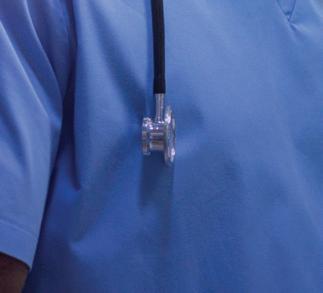
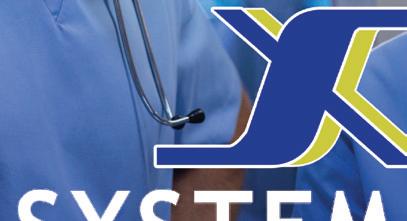












TRACK EVERY STEP OF YOUR SURGERY PROCESS & GET PAID!
No more missing out on your billable work. Surgical Pathways software ensures every aspect of a surgery gets billed. Nothing gets overlooked.
Track Every Step of Each Surgery Process
Engage With Patients Via Text, Email or Call
View All Surgeries & Their Current Progress
Know Who’s Responsible For Each Task
Track Medications
Check Pre-Certs, Forms, Clearance & Billing
Use With Any EHR/PM
Talk with someone with experience working side-by-side with surgeons and billing to learn about the revenue benefits of this revolutionary software.
LEWIS | 256-739-1398
continued from page 1
Children’s is the only team in the state to hold the honor. Their members range from plastic surgeons, advanced practice practitioners, neurosurgeons, orthodontics, ENTs, and nurses to specialists in sleep medicine, speech pathology, genetics, and audiology.
Genetics come into play when some conditions the team face stem from genetic syndromes. The genetic counselors screen the patients for those who might be at risk. “This way, we can find out if the patient also has heart problems or if they have anything related to their brain or their lungs that would need special anesthesia for surgery or other services and medicines and treatments as well,” Smola says.
“We’re a pretty busy center. There’s not a whole lot that surprises us anymore,” Myers says. “A few of the most complex conditions we face include Apert syndrome, Crouzon syndrome, and the more common, Pfeiffer syndrome. These rare genetic disorders cause the bones of their skull to prematurely fuse which can put pressure on the brain. Those particular children wind up needing very in-depth care from an early age all the way up through usually 16 to 17 years old, with a variety of operations along the way.”
“General pediatricians might see some of these diagnoses once in a lifetime, whereas we encounter them almost every day,” Smola says. “They are surprised by the volume and complexity that we take care of.”
Even a cleft lip and palate, the most common condition seen by the team, can take five to six surgeries with care needed over the 18 years of their childhood. It begins at around four months, when the first surgery fixes the lip. Then at ten to twelve months, the team fixes the palate. Before heading to school, they occasionally make a revision to the lip or palate. At eight or so, the patient frequently needs a
bone graft to make their upper jaw a single piece, then a few years later, they may need another surgery if their jaw bones don’t align correctly. The final procedure occurs around 18, with a rhinoplasty.
Many times, the team begins to work with a family before the child is even born. “This is because we may be asked to discuss things with the parents after they’ve had an ultrasound,” Myers says. “And then we wind up taking care of the child from infancy all the way through high school graduation or even beyond.”
“Working with the young patients who spend their first years in the hospital is not as dour as people might think,” Smola says. “They’re fun to see come through the clinic because they’re just having a good childhood, living their life unaware that anything’s different for them because this has been what they’ve known from birth.”
Children’s cleft and craniofacial program has been around for about 25 years, started by John Grant III, MD, who now heads the team and serves as the hospital’s chief of pediatric plastic surgery and craniofacial surgery. “Prior to him being here, there was no coordinated cleft and craniofacial care in Alabama,” Myers says. “We have a long history of outstanding results and getting this additional national accreditation is sort of the icing on the cake.”
The accreditation by the ACPA comes with a listing on their website and referrals to parents who call the association for recommendations. “We’re doing this so that patients can feel comfortable coming to us,” Myers says. “It’s one of the only places in the entire region where you know if you have a baby who has these sorts of problems or if you have a child who’s traumatized, you can comfortably bring them to the Children’s of Alabama hospital and expect that we have all of the equipment, all the expertise, and all the people around or take care of those things very well.”
can be particularly helpful when you have more fragile patients,” Fazendin said.
“Depending on the location, you may be able to use a lighter combination of anesthesia and get through the surgery faster if the imaging gives you a sense of which parathyroid gland is the most likely culprit and exactly where it is.
“The fastest case I ever had took only eighteen minutes, but more difficult cases can take a while. If the problem gland is located near a major nerve not far from the spine, you are going to need heavier anesthesia.
“Although removing one enlarged parathyroid may solve the problem, others may also be overactive. Fortunately, PTH levels change quickly. Ten minutes after removing the adenoma, we can check again. If the PTH is looking good, we’re done. If not, we move on to the next most likely gland. If all four of the
continued from page 3
parathyroid glands are overactive, at least part of the healthiest looking gland will need to remain to provide the hormone, and the patient’s levels will be followed.
“Fortunately, the adenomas are usually benign. Only one case in a hundred comes back from pathology showing a malignancy and needs to be referred to oncology.
“We show patients how to take care of their incisions to minimize scarring, and have them check back a couple of times to verify their labs and see how they are doing. They usually feel better fairly quickly. Six months later, it’s like meeting a whole new person.
“That’s why I enjoy working with hyperparathyroid patients. It’s one disease I can cure with an outpatient procedure and it makes such a difference in their quality of life.”
Carmen V. Lopez, MD is a board-certified physician in gastroenterology as well as internal medicine. She attended Duke University and University of South Alabama College of Medicine. She completed her residency in internal medicine at Tulane University and her fellowship in gastroenterology and hepatology at University of Cincinnati. Dr. Lopez is a member of the American College of Gastroenterology, the American Gastroenterological Association, and the American Association for the Study of Liver Diseases.
Dr. Lopez is now accepting new patients.
GI Associates of West Alabama has provided gastroenterology care to Tuscaloosa and West Alabama for over 30 years. Please join us in welcoming Dr. Lopez to our growing practice.
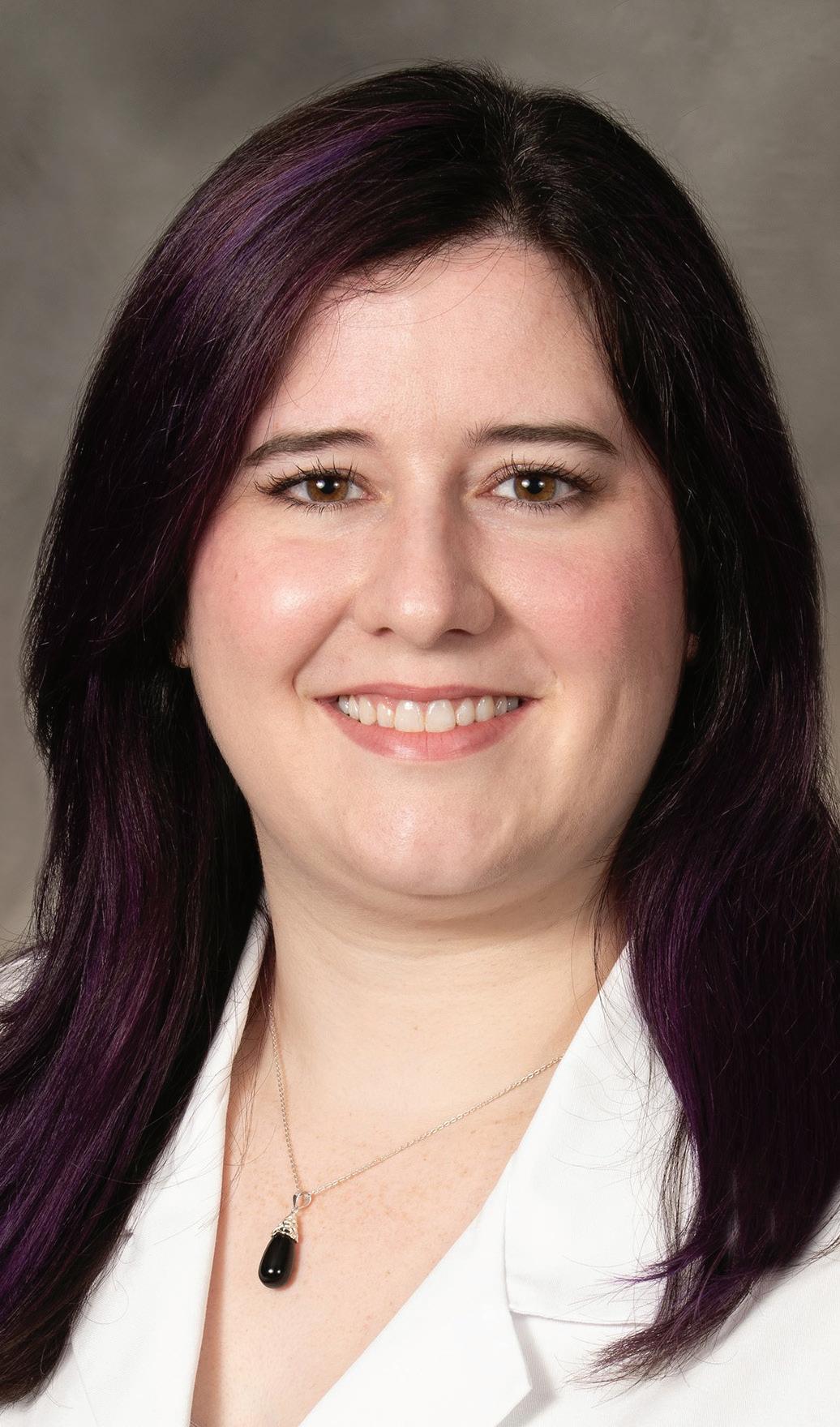

By Jane ehrhardt
“We have more need now for critical care beds,” says Christi Napper, director of facilities development and planning at Children’s of Alabama. In response, the Quarterbacking Children’s Health Foundation, which is the charitable arm of the Monday Morning Quarterback Club, committed $3,000,000 to help relocate and expand the hospital’s pediatric intensive care unit (PICU).
“We decided to create a core area on our campus where our medical patients would be housed,” Napper says. Currently, PICU resides on the 7th floor of the Russell building. The project calls for them to move up to the 12th floor, which is currently an empty shell space that was purposely planned into the 12-year-old building to allow for future growth.
The PICU move allows for the acute care patients now housed in the McWane building to relocate into PICU’s vacated rooms. “So it’s not really an expansion, it’s a relocation and renovation within the Russell building,” Napper says.
The relocations mean all of Chil-
dren’s inpatients will now reside in the same building. “This allows us to be able to have some acuity-adaptable beds,” Napper says. “Now we can do almost the exact same thing in those beds on the 7th floor that we can do up in the PICU beds. So if a patient becomes sicker, they can stay in the same room rather than being relocated across campus.”
The new PICU rooms will include sliding glass doors for better visibility by nurses, more medical gases, and an exam light to enable staff to perform more care within the room. The rooms will be equipped with mobile computers that can be wheeled around the room, replacing the current stationary computers which will free staff from being pinned to one spot.
For the same reason, a second monitor that displays stats will be added to the other side of the bed. “Now it’s only on one side of the room, and they’re having to turn around to watch the monitor, and then turn back to the patient,” Napper says. “So we are trying to make it as efficient as possible for the staff.”
Prior to the start of construction,
(CONTINUED ON PAGE 9)
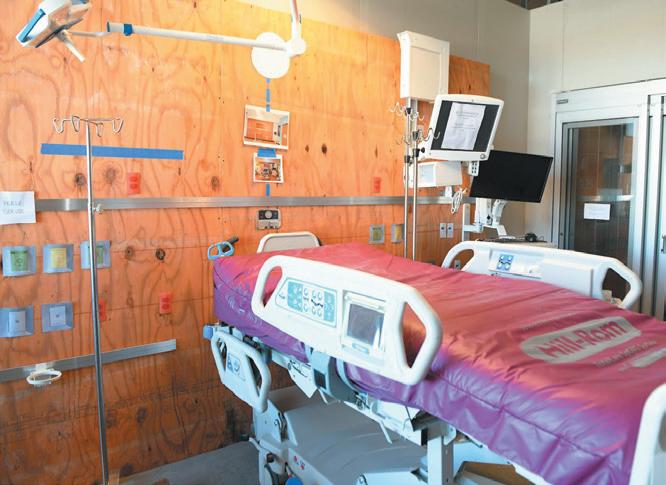


Formed by partners Chae York, Bill Cockrell, and Katrina Shelton, MBCS started in 2020 with two employees providing patient billing and medical clinic management to two healthcare providers. We now provide those reliable, outcome-based services to 100+ healthcare providers.
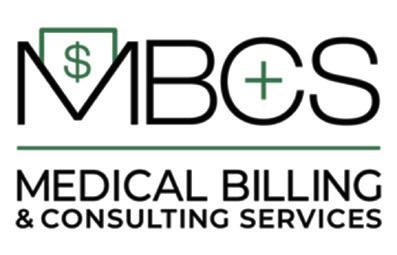




By Marti WeBB Slay
Patient anxiety can be an issue for medical tests at any age, but it can be particularly problematic for children. Children’s of Alabama X-ray suite now offers Philips Ambient Experience to calm children and their parents.
“Kids are already nervous about being somewhere unfamiliar, possibly having to leave their mom’s arms,” said Karen Knight, diagnostic imaging manager. “Older children are still anxious, since they aren’t sure what’s going to happen. Hospital rooms and clinic areas are kind of sterile looking, so there’s anxiety. Is it going to hurt?
“When a child is calm and compliant, the parent is calmer as well. And vice versa. Parents love their children, and sometimes parents are anxious, and children can feed off that. A lot of times they’ve come from the ER and waited a while, so nerves are edge and they don’t know what’s wrong. We try our best to alleviate anxiety for both the parent and the child. It helps the parents to see their child calm down.”
The Ambient Experience combines lighting, sound, and video in a variety of themes to calm the child and make their X-ray experience more pleasant and less threatening. Patients can choose from more than 40 relaxation themes for different ages and cultures.
The CT suite at Children’s has successfully offered the Ambient Experience for 12 years now. Two years ago, a donor paved the way to include it in the X-ray suite as well. “When they walk in, it immediately alleviates all the anxiety, especially since X-rays usually don’t hurt,” Knight said. “We’ve seen with repeat customers, if they know they are coming to X-ray, they aren’t going to be scared. They’ll ask to come to that room, and they get to pick a scene that makes them happy, whether it’s an ocean or mountains or a cartoon. It doesn’t usually take long for them to choose. They are so used to iPads, it goes pretty quickly, but it gives them some ownership of what’s going on, and they really enjoy that.”
Knight said it helps testing go faster. “We always explain what’s going on, but we aren’t having to coax them to leave
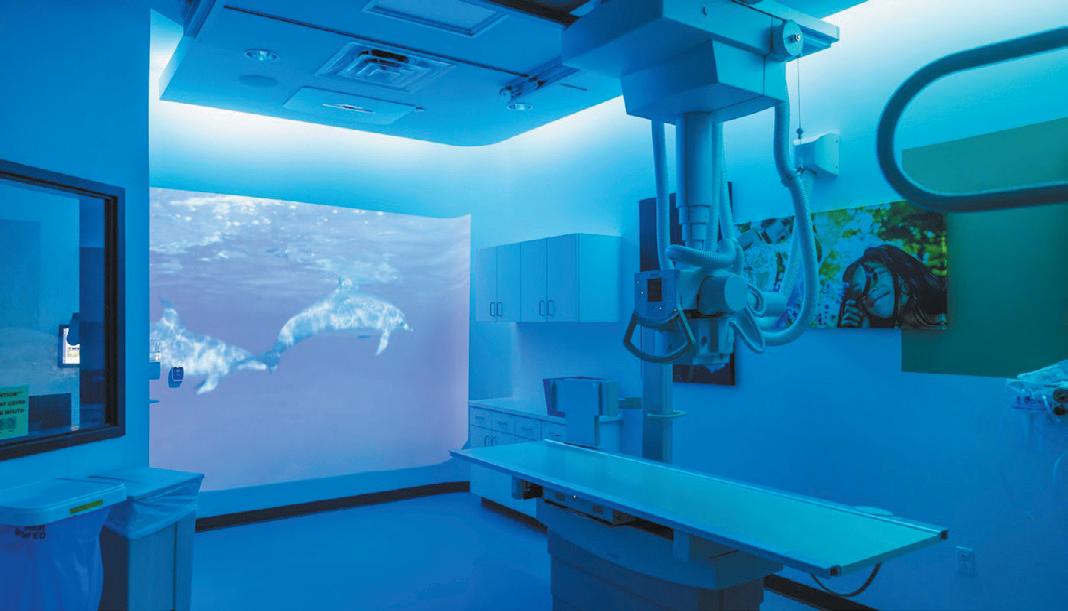
mom’s arms, or lay on the table, or sit in the chair so we can get the X-ray,” she said. “They get fixated on the screen they’ve chosen, and they are more likely to just do whatever we need. We get the images more quickly, because the child is distracted, and when they are distracted, they are more likely to lay still and do what we need them to do.
(CONTINUED ON PAGE 9)
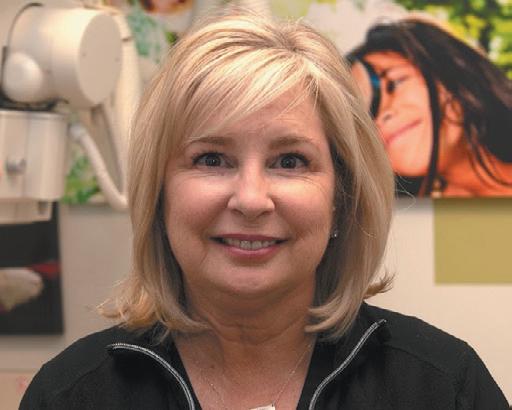
At UAB Medical West, our number one priority is to offer quality, convenient care for those in West Jefferson County, AL. Currently offering emergency care, two health centers in your community, and a brand new state-ofthe-art hospital just down the interstate, UAB Medical West is
family. It’s one more way we can offer quality, compassionate care near you.



By Shannon Britton hartSfield and Brian Platton
Healthcare providers running on thin margins or just seeking new – and in the case of tax-exempt providers, permissible – revenue sources may jump at the chance when third-party vendors offer to help them monetize their patient data. Such ventures, however, are fraught with peril for providers without a solid regulatory compliance program that adheres to all applicable laws, rules and regulations, including those with respect to privacy and security. Providers entertaining such arrangements must use extreme caution as they explore and structure such arrangements, and should consider the following red flags:
Any transaction involving individually identifiable personal data will require careful analysis of applicable law. Entities considering a data sale, licensing agreement or joint venture that contemplates the use of patient data need to review applicable federal law, as well as the laws of the states where the parties are located
and the states where the individuals who are the subjects of the information live. Different laws may apply depending on the nature of the data. For example, the federal privacy and security regulations implementing portions of the Health Insurance Portability and Accountability Act (HIPAA) impose restrictions on the use and disclosure of protected health information (PHI). With limited exceptions, HIPAA requires written authorization from an individual if the PHI will be used or disclosed for something other than treatment, payment or healthcare operations.
Other laws may apply as well, depending on the type of data involved. Providers offering substance use disorder treatment programs will likely have to comply with confidentiality and privacy regulations found at 42 C.F.R. Part 2. The Federal Trade Commission strives to protect consumers by requiring companies to abide by their own privacy policies when it comes to protecting an individual’s data. If those privacy policies contain broad statements suggesting that an individual’s information will only be used for certain limited purposes, those policies could impede the company’s abil-
ity to monetize data.
In addition, different states have different restrictions depending on various factors, including the health condition involved and how the data was sourced and produced. These restrictions may be more stringent or address different matters than HIPAA.
HIPAA violations can lead to criminal penalties. Selling, transferring or using PHI for commercial advantage, personal gain or malicious harm can result in fines of up to $250,000 and imprisonment for up to 10 years. Providing access to PHI in exchange for money or other valuable consideration could implicate this prohibition. Further, for tax-exempt entities, selling, transferring or using PHI for commercial advantage may be inconsistent with the charitable purposes of the organization.
Once PHI is properly de-identified, HIPAA no longer applies. Sometimes companies will buy or sell data sets they

Ryne Black, M.D.

believe are completely de-identified because names, addresses, social security numbers and other direct identifiers have been scrubbed. This does not guarantee, however, the information is sufficiently de-identified. HIPAA has two methods of de-identification: the so-called “safe harbor” method and the “expert determination” method. Under the safe harbor, a number of data points must be removed, including all dates related to an individual other than the year. Therefore, if a company wants to purchase a data set that contains the day, week or month of a lab test or some other medical service, the information is not de-identified unless an appropriately qualified statistician or other expert properly documents that the information is, in fact, de-identified and will remain so.
Before a covered entity discloses PHI to business associates, HIPAA requires the covered entity to obtain satisfactory assurances, in the form of a written business associate agreement, that the business associate will use and disclose the
(CONTINUED
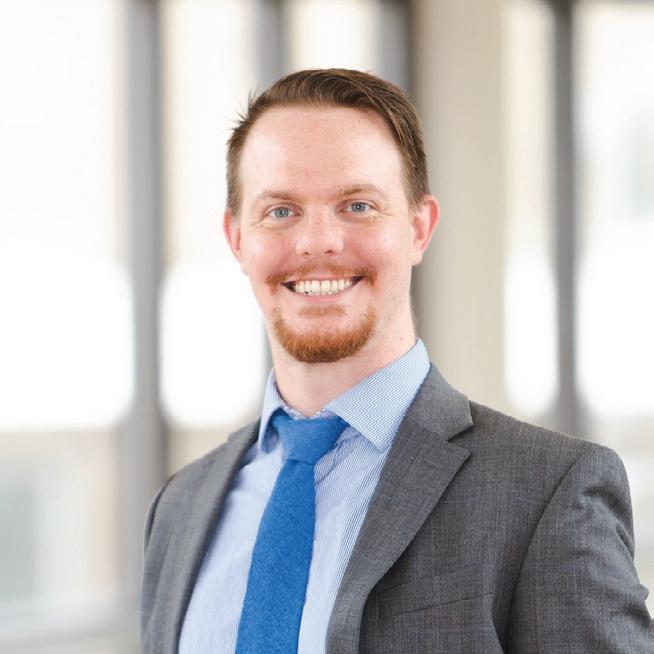
Taylor Kuhlman, M.D.
Landen Tharp, M.D.
continued from page 6
Children’s created a mock-up room to gain input on the planned renovations from staff, patients, and families. Staff recommendations were minimal, including adjusting the placement of outlets and gases around the bed. “We moved a couple of outlets over just six inches, but that will make a huge difference once you get all the ventilators and other equipment in the room,” Napper says.
Families requested additional USB ports, more storage for all the things they bring from home, another washer and dryer in the laundry room, and a second towel rack. “Something as little as a towel rack in the bathroom is a small thing, but it means a lot to our families,” Napper says. Their suggestions also led to a reading light being added for when the room lights need to be off, but the parents wish to continue working or reading.
All of the lights will now be dimmable, as well. “There are a lot of increased sensory needs now for patients, and light can be a trigger for some,” Napper says. “It also gives them a bit of control in their room, which is important because some patients are nervous, and they want to be able to control something in their space.
“Being able to build from an empty
Suite, continued from page 7
“We’d like to see the experience in more X-ray rooms. Until then, the room equipped with Ambient Experience is the first choice for both our patients and the X-ray techs. It’s a huge distraction for the kids and makes our jobs easier and more efficient and quicker, and really safer, because you and the moms aren’t fighting with the kids to lay down.”
shell has allowed us to solve another problem. Right now, adding equipment to the PICU rooms can require adding wiring and ports. So we’ve put in additional power and data in these new rooms. It’s giving them the flexibility of what they’ll need to do in the room down the road.”
With diagnostic imaging and most of the ORs already located in the Russell building, having all acute and PICU patients in the same building will be a gamechanger for the staff. They will no longer have to walk from one building to another to see patients or collect them for imaging. Now it will be just an elevator ride away.
For those acute patients and their families now occupying the 45 beds in the McWane building, the advantages of the move are just as great. Besides not having to cross a walking bridge to another building to attain images, it alleviates the need to navigate the large campus during already stressful times. “Now all they will need to know is within one building,” Napper says.
Construction on the new PICU rooms has just begun and is projected to be complete by the end of the first quarter of 2026. The first patient would move into the new PICU shortly after.
When people with extraordinary talent and passion are given the technology, the facilities, and the support, they achieve great things. The discoveries and innovations happening today will help shape the future of treatments and lead to cures. And it benefits not only the patients and families who come to Children’s of Alabama, but people across the country and around the world for years to come.
Pediatric themes include Ollie in Space, Carousel, Chris on Treasure I sland, Doris on the Farm, Finding Doris, Fantasy, Jungle, Olly’s Adventure Walk, Sky, Underwater, and Victor the Fish.
Nature themes include Spring Forest, Starry Night, Desert Scenery, Oceans, Panda, Water Sunset, Water Views, and Paradise.
Location themes include Africa, Asia, Australia, Chinese Paradise, Holland, Japanese Garden, Jordan, Mediterranean, North America, and South America.
•
•




By laura freeMan
Like so many 23-year-olds with a newly minted degree, Mendel Fishman felt immortal.
“I was a runner in good health and just starting a career in finance. What I hadn’t taken into account was that it was 2020—the year COVID-19 changed everything,” he said.
Fishman survived the acute phase of infection by the virus that killed millions of people around the world, but he was left with the lingering health challenges of long COVID that made his body feel like it was no longer his.
“The fatigue, the joint and muscle pain were bad enough, but the respiratory problems went on and on,” he said. “There was nothing I could do that made it any better. In the past, when I was getting over a cold or the flu, I could build back my respiratory capacity and clear my lungs by just going for a run and gradually getting back to normal. This time it didn’t work.”
When Fishman went back to his doctor, he learned that his lingering symptoms were consistent with an emerging syndrome that was showing up in


















COVID patients. It had a name, but no test that could definitively diagnose it.
“They called it Long COVID,” he said. “The CDC’s best guess as of March 2024 was that about seven percent of U.S. adults, around 17 million people, suffer from it. That’s not just a personal and public health problem. With so many people unable to function at the same level and do what they did before, that’s an economic crisis.”
According to CDC figures, about one in five people age 18 to 64 who are infected with COVID-19 will eventually develop long COVID. For people over 64, the risk increases to one in four.
In addition to exhaustion similar to chronic fatigue, long COVID may include neurological symptoms such as brain fog, loss of sense of taste or smell, dizziness on standing, pins and needles sensations, depression and anxiety. Muscle and joint pain are often a problem, and there may be continuing respiratory, heart, immune and digestive system issues as well as other problems that may differ from patient to patient.
“Long COVID completely changed my perspective on life. Instead of just a career in business, I became passionate























about using the administrative skills I had learned in school to do something to contribute to the effort to overcome long COVID,” Fishman said.
After looking into the many needs associated with the disease, Fishman decided he could be most useful by starting at the beginning and pulling resources together to launch a research organization that focuses on developing a diagnostic test that can definitively tell doctors whether a specific patient has long COVID.
“It isn’t just that patients need to know that they have the condition so their doctors can develop a treatment plan,” he said. “Researchers also need to better
understand the mechanisms behind the disease in order to work on new ways to fight it. For a clinical trial to provide useful information, researchers need to know for certain which subjects actually have long COVID. To know whether a new drug is working, they have to be able to measure a patient’s condition before the drug for a baseline to compare it to after treatment.”
With this goal in mind, Fishman founded Celestia Diagnostics, a biotech incubator company located in Southern Research Institute’s Station 41.
“I recruited Hanan Chweih Vendrame, PhD to head up research,” he said. “We’ve just added a data analyst and we anticipate adding more people as the work progresses.”
Celestia Diagnostics is looking at multiple biomarkers and comparing their potential to serve as the basis of tests that could answer the question of whether long COVID is responsible for a patient’s suffering.
“It isn’t enough to look for antibodies,” Fishman said. “A patient may have antibodies because they had COVID or were vaccinated. They also may have







Chad Colon, MD is an electrophysiologist practicing with Cardiovascular Associates and is affiliated with Brookwood Baptist Medical Center. He received a Bachelor of Science degree in biology and his Doctor of Medicine from the University of Alabama. He completed his residency and earned his fellowship in cardiovascular disease and fellowship in electrophysiology disease at the University of Alabama at Birmingham. He is board certified in internal medicine and cardiovascular disease and has published manuscripts pertaining to atrial arrhythmias.
Dr. Colon specializes in the following:
• Atrial fibrillation
• Atrial flutter

• Cardiac device extraction
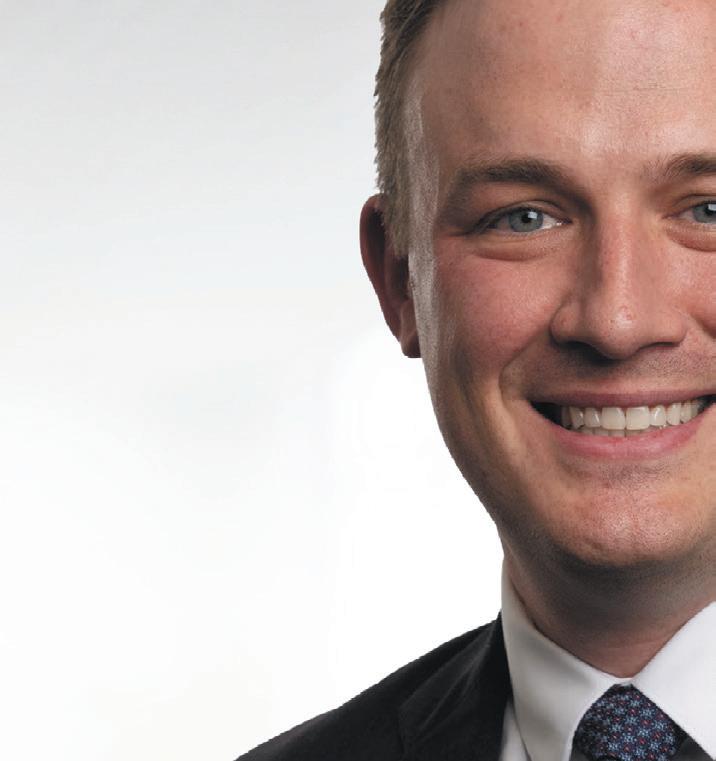
• Cardiac device implantation and management
• Conduction system disorders
• Left atrial appendage occlusion
• Supraventricular tachycardias
• Ventricular tachycardia
Dr. Colon is now accepting new patients.



Cardiovascular Associates
3980 Colonnade Pkwy. Birmingham, AL 35243




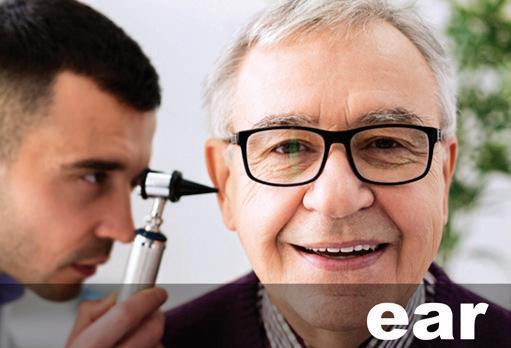


If you suffer from allergies or other ear, nose, throat or hearing problems, we don’t want you to treat your healthcare lightly or ignore symptoms that could lead to more serious issues. Call us now for a complete evaluation with one of our 15 board certified physicians, 4 highly trained and licensed PAs, or 16 clinical audiologists — all available to serve your needs at any of our 10 locations.

Five Red Flags, continued from page 8
PHI only as permitted by that agreement. Except under very specific circumstances relating to its own proper management and administration or to fulfill its legal responsibilities, business associates cannot use PHI for their own purposes. If a business associate will be de-identifying PHI so it can be licensed or sold, the business associate agreement must permit that activity. The business associate must have sufficient HIPAA compliance programs in place and the ability to de-identify PHI in accordance with the regulations. Business associates that wish to retain PHI for purposes other than de-identification should generate an immediate red flag.
Even if data is properly de-identified and no longer subject to HIPAA, it can lead to significant risk if the entity providing the de-identified information relinquishes all control. A limited license to further use and disclose the data set, as opposed to an outright sale, can help ensure that privacy is protected going
forward. For example, if information is de-identified in accordance with the expert determination method, the expert may require further protections of the data. The information may still need to be subject to a contract that restricts how the recipient will be allowed to use it, and that prevents the recipient from trying to re-identify it.
An overarching guiding principle when evaluating data monetization opportunities can be found by asking the following question: “What would the patient expect?” If the provider can point to patient-facing disclosures or communications that adequately explain how the anticipated data use or the proposed arrangement is necessary for the provider’s own treatment, payment and healthcare operations efforts, the red flags are likely to stop waving.
had both and their immune system simply failed to produce antibodies that we can detect.”
Fortunately, Celestia is identifying other potential biomarkers and indicators they are studying to determine their feasibility for developing for testing.
“The most recent biomarker we are looking at now involves fibrin amyloids that are associated with microclot formation,” Fishman said. “They seem to be common, but we still have to determine the mechanisms involved and how reliable they are as an indicator. We are likely to look at a lot of possibilities as we narrow down the most effective ones.”
According to NIH reports, fibrin amyloid microclots are frequently found in long COVID patients and could be involved in triggering an immune system response that could explain some of the


continued from page 10
symptoms that are often reported with long COVID.
“Once we determine the right target, the next step will be developing it into a diagnostic test that can be used in trials,” Fishman said. “When clinically proven and on the market, there will still be plenty of work ahead. So many infections, especially viruses like COVID, leave a lot of problems in their wake, including health issues that may go on for years.”
The immune system, the genetics and epigenetics involved in health issues seem to be frequent targets of viral infections and may be the trigger for other health problems. Tracking what germs are doing and providing clues on how to overcome their effects is likely to create plenty of work to keep Celestia Diagnostics and Mendel Fishman active throughout a long career ahead.





























Networkoscopies
Show what the hackers can see So you don’t get screwed.
#cyberhaiku

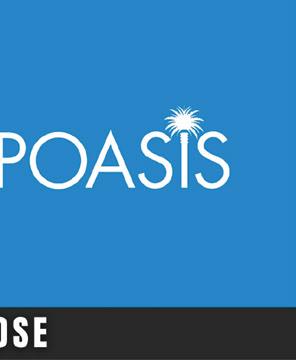












We’re aiming to raise $20,000 for Hand in Paw by the end of the year!
Book a 15-minute discovery, and we donate $150 in your name.
Become a client, and we donate half of the onboarding fee in your name.

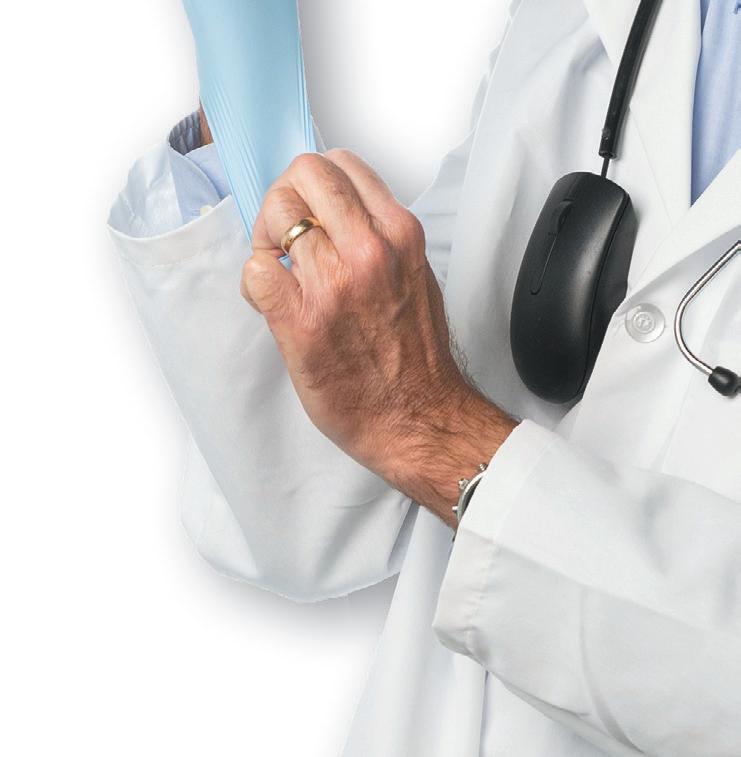





They brighten days, embolden those facing challenges, and bring relief to kids and adults facing medical, learning, and societal hardships. Their volunteer teams take therapy-trained pets to medical centers, schools, and human service organizations throughout north central Alabama and Tuscaloosa. Their volunteer teams make thousands of beneficial visits helping countless children with special needs, at-risk youth, struggling students, and people with chronic and terminal illnesses.
By tara arrinGton
In today’s online environment, it’s more important than ever to leverage digital marketing tools to help your practice succeed. If you feel lost, don’t worry. There are many ways to improve your online presence, whether you can afford to hire a marketing firm, or you plan to handle it in-house.
Though we’re focusing on the digital world, most if not all your services are probably offered in person. Your practice’s location can either be the key to your prosperity or downfall, so your location should influence your digital marketing strategy. Analyze surrounding areas and population metrics to understand who your potential patients are. This will help you develop more targeted marketing strategies, which are typically more successful.
One of the most important parts of your digital marketing plan is developing a website that is optimized for search engines and easy to use. A healthcare advisor can guide you through this process or help you find a marketing firm to set up and host your website. If you are web savvy, setting up a site via a platform like Wordpress is relatively easy, and you can avoid the high fees that sometimes come

Tara Arrington
with a marketing firm. After setting up your site, hire a freelance designer to improve the look and feel. Be sure your website includes information like your hours, contact information, and key links for patients, such as the patient portal or forms.
A common phrase in the digital marketing world is, “Where do businesses go to die? The second page of Google.” Your search engine optimization (SEO) determines where your business ranks in search engine results. One of the best ways to improve your SEO is by including relevant keywords on your website. Research relevant keywords relating to your specialty and combine those with location-specific keywords.
Another way to improve your SEO is through blog posts. Blog posts allow you to target a patient looking for a particular procedure or treatment while offering educational information. To succeed, blog posts should contain original content and relevant keywords. For example, if you are a surgeon targeting patients seeking weight loss treatments, you could write about bariatric surgery benefits, including keywords like bariatric surgery near me; gastric sleeve near me; gastric bypass near me; gastric sleeve cost; and gastric bypass cost. Leverage artificial intelligence (AI), such as ChatGPT, to generate blog ideas or even an outline. However, it is best to write your own blog posts or work with a freelance copywriter to produce them instead of using AI to create the entire post. Original content will perform better with search engines, allowing your blog post to rank above competitors.
If you’re still looking for ways to drive potential patients to your site? Consider search engine marketing (SEM). This includes ads with search engines like Google. You determine how much you want to spend with Google Ads, allowing flexibility for all budgets. If you’re lost, try working with a digital agency that specializes in SEO and SEM.
After setting up your website, create a Google Business Profile. A Google Business Profile is one of the top ways patients find you. Don’t forget important information like your address, phone number, website address, hours of operation, and appointment link, if applicable. Including photos of your providers and your space will also help your profile rank higher with Google. Reviews power your Google rating, the stars you see below a business name, and capture word-of-mouth marketing for everyone to see. Encourage patients to leave your business a review, especially if they seem pleased. While positive reviews improve credibility, negative reviews can damage your reputation. If you receive a negative review, be sure to understand the patient’s experience before responding. Following your research, respond in a timely manner, maintain a professional tone, and offer opportunities to discuss further offline.
If you already have a Healthgrades profile, update your profile as needed. If you don’t have a profile, set one up. It’s free and relatively easy.
Social media is another free resource to promote your business, but it must be used to be successful. If you don’t have







By Kelli C. Fleming
On June 31, 2024, the Department of Health and Human Services (“HHS”) published a final rule establishing penalties for healthcare providers who violate the information blocking rules implemented under the 21st Century Cures Act. Until the recent publication of this final rule, there were no penalties in place for violation of the information blocking rules by healthcare providers, although complaints relating to violations by healthcare providers could be filed.
As a refresher, the information blocking rules prohibit a healthcare provider, among other “actors” as defined in the rules, from taking any action that is likely to interfere with the access, exchange, or use of electronic health information contained in a designated record set (“EHI”), unless the action is required by law or an applicable legal exception is met. The eight exceptions to the information blocking rules are complex and each one contains a number of factors that must be met in order to qualify for the exception. The information blocking rules apply to a request for EHI from any requestor, not just a request to access information from patients. Further, compliance with HIPAA

Kelli Fleming
does not necessarily equate to compliance with the information blocking rules.
Previously, the Office of Inspector General (“OIG”) published a final rule establishing civil money penalties for violations of the information blocking rules by health IT developers, entities offering certified health IT, health information exchanges, and health information networks. The latest final rule implements penalties for healthcare providers who violate the information blocking rules by allowing the OIG to refer such providers to the Centers for Medicare & Medicaid Services (“CMS”) for payment disincentives. The method of payment disincentive depends

on the type of provider involved.
For eligible hospitals and critical access hospitals, the disincentive involves not being deemed a meaningful electronic health record (“EHR”) user during a relevant period of time. If the eligible hospital is not a meaningful EHR user, the eligible hospital will not be able to earn certain reimbursement incentives. This disincentive will be effective 30 days after publication of the final rule.
Under the Promoting Interoperability performance category of the Merit-based Incentive Payment System (“MIPS”), a MIPS eligible clinician who has committed information blocking will not be a meaningful EHR user during the calendar year of the applicable performance period. If the MIPS eligible clinician is not a meaningful EHR user, then they will receive a zero score in the MIPS Promoting Interoperability performance category, which will impact MIPS performance and related incentives. The disincentive will only apply to the individual, even if the individual reports as part of a group practice. This disincentive will be effective 30 days after publication of the final rule.
OIG will consider four elements when investigating information blocking violations and determining if a disincentive should be imposed: (1) whether the practice caused or had the potential to cause patient harm; (2) whether the practice impacted the ability to care for patients; (3) whether the practice was of a long duration; and (4) whether the practice caused financial loss to a federal healthcare program. Disincentives will not be imposed for conduct occurring prior to the effective date of the final rule.
“This final rule is designed to ensure we always have access to our own health information and that our care teams have the benefit of this information to guide their decisions. With this action, HHS is
Under the Medicare Shared Savings Program, a healthcare provider that is an Accountable Care Organization (“ACO”), ACO participant, or ACO provider or supplier who has committed information blocking may be ineligible to participate in the program for a period of at least one year. Consequently, the healthcare provider may not receive revenue that they might otherwise have earned through the Shared Savings Program. This disincentive will be effective 30 days after publication of the final rule; however, any disincentive would be imposed after January 1, 2025.



The Alabama Rural Medical Service Awards (ARMSA) incentivize family medicine, internal medicine, pediatric medicine, Med/Ped physicians, and family medicine nurse practitioners to practice in rural, medically underserved areas in Alabama. ARMSA offers $50,000 a year for primary care physicians, with a 3-year maximum award period. The award is a service loan that is payable by years of service.







By GeorGina Perry, CPa, CMPe
When you consider technology’s role in healthcare, you might think of clinical advancements like surgical robotics or wearable devices. Less widely known is the technology working behind the scenes to improve the efficiency and outcomes on the administrative side of the industry.
Technology and computers received a big push in healthcare administration in the early 2000’s with the Meaningful Use incentive and the availability of affordable accounting software like QuickBooks. Meaningful Use offered providers a financial incentive to utilize electronic medical records to create and collect healthcare data, which forced administrators to examine how the new EMR would communicate with their existing billing software. QuickBooks allowed medical practices to prepare their own bookkeeping in real time and prepare reports based on current data with just a few clicks.
Recently, much of the technology conversation is around Artificial Intelligence (AI) and the healthcare industry is no different. AI can be described as the application of machine learning algo-
rithms used to imitate human thinking. As with the implementation of EMRs and QuickBooks, some jobs were eliminated, but new jobs and roles were created, as well. Let’s examine some of the administrative areas of healthcare that continue to benefit from advancements in technology.
One area that has evolved with recent technology is patient scheduling. Many practices have already implemented a chatbot to aid patients with online appointment scheduling, as well as to answer frequently asked questions.
A chatbot is a program that simulates human conversation with an end user.
The chatbot may ask the user a few standard questions to find the next available opening on the schedule, or route the patient to the correct staff for further assistance. Some chatbots are equipped with AI to respond in a more personal way and have access to more patient and practice data to make decisions about what questions to ask the user in order to assist them in scheduling an appointment that both fits the practice’s parameters as well as the patients preferences. Technology like chatbots with or without AI are designed to automate the scheduling

Georgina Perry
process to ultimately remove the human involved in scheduling.
Medical billing automated electronic claims filing and electronic payment posting long ago. Automating those oncemanual processes freed up billing staff to spend more time on working rejections and other issues. Medical billing technology that involves AI is trained to review coding, payment patterns, and history to predict the order in which claims should be worked by billing staff according to the likelihood payment will be made. AI is also responsible for the suggested coding provided based on the software’s assessment of the documentation and informa-


Our team of 15 board-certified physicians specializes in minimally invasive procedures to capture the latest in treatments with the most e ective outcomes for each patient.
WE ARE LEADERS SPECIALIZING IN:
• Chest pain & hypertension
• Peripheral Artery Disease
• Cutting-edge therapies
• Watchman & treatment of AFIB
• Venous disease & procedures
• Interventional cardiology including TVAR, TCAR, and EVAR procedures
tion input by the clinical staff. Suggested coding allows for efficient and correct coding to be reviewed and approved by trained medical coding staff without them having to start at square one with every claim and code. By allowing the software to take over the mundane tasks involved in the medical billing process, the staff are now free to focus on the data that is available to monitor patterns, issues and updates.
Medical transcription processes have changed dramatically as a result of advances in technology in healthcare administration, having evolved from the provider dictating into a recorder and a transcriptionist typing the notes on a typewriter to software that records voice to text on your phone and AI guiding the text to the correct part of the note. What used to require two people and multiple days now can be completed by the provider in a matter of minutes with specific software.
Healthcare will continue to evolve as new technology is developed. The technology is pushing changes within practices to happen faster and faster. How can medical practices keep pace? Be ready to























































By Marti WeBB Slay
Since stroke is the leading cause of death and disability in the US, Jitendra Sharma MD, MS, with Brookwood Baptist Health System, wants physicians to communicate more with their patients about stroke, its prevention, risk factors, and the growing prevalence of it in younger populations.
“We are realizing that prevention is more important than treating the disease,” Sharma said. “We are now seeing stroke in younger populations, in those who are in their 40s and 50s. Why? The number one issue is obesity.
“The new information we need to bring to the younger community is they should exercise three times a week, eat healthy, and keep weight under control. Because if we can manage our weight, that will prevent blood pressure and cholesterol issues, and that can prevent a stroke or heart attack in the future. That’s where the money is now.”
The risk factors for having an ischemic stroke, or stroke due to blood clot, are age itself, high blood pressure, diabetes, cholesterol issues, smoking, atrial fibrillation and irregular heart rate. Smoking and high cholesterol are also high-risk factors for hemorrhagic stroke, or stroke from a brain aneurysm or a brain bleed due to high blood pressure.
“The discussion should be started early, although changing at-risk behaviors at any time can make a difference,” Sharma said. “Smoking increases the risk of blockages of carotid artery and arteries of the heart. If someone can quit smoking, their risk drops down. Same thing is true of blood pressure, cholesterol and diabetes. Maximizing risk factor management means maximizing medications and healthy lifestyle to reduce the risk of stroke.
“It’s important for patients to understand the signs of stroke so they can respond quickly. Patients should be taught the acronym BE FAST: Balance loss, Eyesight (vision problems), Face drooping, Arm weakness, Speech difficulty, and Time -- call 911 immediately.
“We have a saying about Ischemic stroke: time is brain. Anyone having a stroke may have speech problems, difficulty talking, or feel weak on one side. If that happens, we know blood flow to the brain has stopped. We say time is brain, because every minute, millions of brain cells can die, so call 911 and get to the hospital.”
A stroke victim may be eligible for

clot buster medications, or thrombolytic therapy, to halt ongoing damage from ischemic stroke. If they come to the hospital within a three-hour window, they may be eligible for IV medication that can dissolve the clot and restore the blood flow.
“Another aspect of ischemic stroke is carotid artery disease, or blockages in the neck,” Sharma said. “That also has to be treated so we may schedule a visit to the clinic for a carotid stent. Patients with carotid artery disease may experience a transient ischemic attack (TIA), which is a temporary shortage of blood flow to the brain, and then improve. TIA are signs for bigger stroke in the future.”
Two Birmingham hospitals offer an


additional treatment for ischemic stroke.
“In patients where the clot buster medication may not work, we can do mechanical thrombectomy,” Sharma said. “We go inside the blood vessel and pull the blood clot out. This special procedure helps us extend the window 24 hours for anyone who is having a stroke and threw a blood clot that’s closing the vessel. In Birmingham, only two places offer mechanical thrombectomy, Brookwood and UAB. Brookwood typically receives mechanical thrombectomy patients within a 100-mile radius.”
Brookwood also offers a special technique for hemorrhagic stroke to close off the aneurysm with a minimally invasive approach called aneurysm coiling, also known




as endovascular embolization. Coils made of soft platinum metal and shaped like a spring are inserted into an aneurysm to prevent blood flow, in order to keep the aneurysm from rupturing. Once the aneurysm is closed off and the patient is evaluated, they can go home the next day.
Sharma feels that more discussion between physicians and patients about stroke will not only encourage patients to develop better preventive strategies, but will also help the physician identify patients who may be at higher risk for stroke. “If they notice an at-risk patient, send them to us and we can screen them better,” he said. “Any time they are worried about aneurysm or carotid artery disease, or TIA, a stroke work up should be completed. Refer them to us for further evaluation.”


























continued from page 15
taking a critical ste1p toward a healthcare system where people and their health providers have access to their electronic health information,” said HHS Secretary Xavier Becerra. “When health information can be appropriately accessed and exchanged, care is more coordinated and efficient, allowing the healthcare system to better serve patients. But we must always take the necessary actions to ensure patient privacy and preferences are protected – and that’s
exactly what this rule does.”
Noticeably missing from the final rule are disincentives for other types of healthcare providers, for example, nursing homes, home health agencies, group practices, DME suppliers. Thus, additional incentives may be forthcoming through future rule-making.
Kelli Fleming is a Partner at Burr & Forman LLP practicing exclusively in the firm’s Health Care Practice Group. Kelli may be reached at (205) 458-5429 or kfleming@burr.com.
time to consistently post on social media, consider working with a marketing firm or a freelancer to help. Freelancers are generally more affordable than working with a traditional firm, but they may not offer as many services. A freelancer can set up your accounts, create evergreen content, and train an employee to manage them. If the idea of digital marketing leaves
continued from page 14
you feeling frustrated, don’t be afraid to work with a healthcare advisor. Even if your advisor isn’t a marketing maven, they can find the right expert for you, all while protecting your bottom line.
Tara Arrington is the Leader of Marketing, Communications, and Engagement for Kassouf & Co.
continued from page 16 reexamine your processes frequently as there might be a more efficient way to do things today. Stay up to date with new or improved capabilities of the software you already have. You might not need to spend a lot of money to have access to the latest developments. Create a community of sharing with your professional peers. Learn from each other’s experience and technology.
Georgina Perry, CPA, CMPE serves as the Director of Physician Services at Carr, Riggs & Ingram.









Tenet Healthcare has sold its 70 percent stake in Brookwood Baptist Health to Orlando Health, a private, not-for-profit healthcare organization. The $910 million transaction includes Brookwood Baptist Medical Center, Princeton Baptist, Walker Baptist, Shelby Baptist, and Citizens Baptist. These hospitals have over 1,700 beds, more than 70 primary and specialty care clinics, about 1,500 affiliated physicians and more than 7,300 employees.
As part of the deal, Tenet’s Conifer Health Solutions subsidiary will enter
into a new and expanded 10-year contract to provide revenue cycle management services for the hospitals.
Thibaut van Marcke, who currently serves as senior vice president of Orlando Health Southeast Region, and president of Orlando Health’s Dr. P. Phillips Hospital, will lead Orlando Health in Alabama.
The transaction is expected to be completed this fall, subject to regulatory approvals, clearances, and closing conditions. The system will be named Baptist Health following closing.
Holland & Knight has been named the largest healthcare law firm by Modern Healthcare. The annual Largest Healthcare Law Firms rankings are determined by the headcount of healthcare lawyers employed by U.S. law firms with a dedicated healthcare practice as of December 31, 2023.
In March 2023, Holland & Knight combined with Waller Lansden Dortch & Davis, expanding the firm's Healthcare & Life Sciences Industry Group to more
than 400 experienced attorneys covering virtually every segment of the healthcare industry. Previously, both firms had been consistently ranked on Modern Healthcare's annual list for over 15 years.
The firm's Healthcare Industry Group focuses on hospitals and health systems, post-acute care, ambulatory surgery centers, outpatient care, private equity, physician practice management, behavioral health, digital health, managed care, pharmacies and life sciences.





The place for Alabama healthcare jobs













This September, in recognition of Gynecologic Cancer Awareness Month, the Laura Crandall Brown Foundation (LCBF) will commence its 12th annual A State of Teal Awareness Campaign and host its Head Over Teal 5K/10K. LCBF’s A State of Teal Awareness Campaign aims to increase awareness about gynecologic cancers through advertising and events.
The Head Over Teal 5K/10K will be held in the Hoover Preserve subdivision on Saturday, September 28. Event features include: 5K and 10K races, food, music, family friendly games, and face painting. Participants have the opportunity to raise funds individually or as a team. Online registration is available by visiting www.thinkoflaura.org/headoverteal


There’s no reason to leave those delinquent dollars hanging. With HIPAA compliancy in mind, DiRecManagement has an in-depth understanding and experience in handling the nuances of insurance reimbursement. We know how to gather in your medical receivables while retaining your reputation and patients.
The Alabama Department of Public Health Bureau of Clinical Laboratories has begun testing newborns for two treatable genetic disorders. With a simple blood screen and treatment, most affected babies have the opportunity to avoid death and disability and grow up healthy and develop normally.
buildup of toxic materials in cells. There is wide severity and age of onset with the most severe form (Hurler syndrome) beginning within the first year of life.



The new disorders added to Alabama’s newborn screening panel are: Pompe disease, which is a rare genetic disorder caused by a deficiency of an enzyme resulting in the build-up of stored sugar, leading to severe muscle weakness. The disease can be fatal without early detection and treatment.
Muccopolysaccharidosis Type I (MPS I) is a rare genetic disorder caused by a deficiency in an enzyme resulting in the
Close coordination is needed for newborn screening follow-up. For these two conditions, the ADPH is partnering with UAB to evaluate and confirm diagnosis, and ADPH provides information to healthcare providers and families for appropriate treatment.
The ADPH Bureau of Clinical Laboratories is the sole provider of blood analysis of newborn screening in Alabama. ADPH identifies approximately 200 babies each year with a metabolic, endocrine, hematological, or other congenital disorder. These babies usually look and act healthy at birth.

Steve
VICE
Jason Irvin
CREATIVE DIRECTOR
Katy Barrett-Alley
CONTRIBUTING WRITERS
Jane Ehrhardt, Ashley Franco, Laura Freeman, Lynne Jeter, Marti Slay
Birmingham Medical News
270 Doug Baker Boulevard, Suite 700-400, 35242 205.215.7110
AD SALES: Jason Irvin, 205.249.7244
All editorial submissions should be e-mailed to: editor@birminghammedicalnews.com

The Alabama Healthcare Leaders Association held its summer conference in Gulf Shores at the end of July with 54 healthcare-related companies manning exhibitor booths, and nearly 100 medical practice executives in attendance.
The first morning opened with breakout sessions for managers of specialty practices that included OB/GYN, Orthopaedics, Primary Care, Dermatology, Multispecialty, Pediatrics, Pulmonary, and Surgery. There were a number of breakout sessions over the next two days. Helen Combs of Medovation Clinical Research gave a talk on the
importance of employment contracts. Janet Day, MBA, CMPE with Kassouf & Co discussed the requirements for compliance with Payment Card Industry and Data Security Standard. Josh Kirkland with Attentive Preventative Care Management explained how practice managers can save thousands in payroll taxes while providing more employee benefits. And Maddox Casey of Warren Averett discussed the struggles practices can have with billing, collections, and cash flow, and explained how to implement solutions to these problems in order to achieve financial stability.
The American Heart Association has announced new officers to serve on the Southeast Board of Directors for the 2024-2025 fiscal year, and Andre McShan, MD has been selected to serve as the board’s president-elect.
McShan is an assistant professor in the UAB Department of Physical Medicine and Rehabilitation, medical director at The Workplace at UAB Highlands, and co-medical director of UAB Employee Health. He has held multiple
leadership roles with the American College of Occupational and Environmental Medicine.
He has served at the local, regional and national levels of the American Heart Association in various leadership roles.
The Southern Medical Association is holding their annual Scientific Assembly at Crowne Plaza Perimeter in Atlanta from October 24 through October 26. The conference theme this year is Proactive Medicine in a Reactive World. Experts will discuss the latest research and provide practical tips to help physicians improve patient care. Every presentation is peer-reviewed by SMA’s Planning Committee of respected clinicians, ensuring that all content complies with or exceeds the ACCME’s educational standards.
The Southern Medical Association is accredited by the Accreditation Council for Continuing Medical Education to provide continuing medical education for physicians.
To receive $150 discount off, use code WEB2024 when registering. This offer ends August 31, 2024.

A past member of the national Workplace Health Steering Committee, he was also the president of the

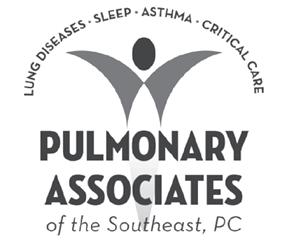
Birmingham Metro Board. He was an early volunteer in the Association’s Scholars Program at Historically Black Colleges & Universities (HBCUs) and served on the Southeast region’s HBCU Task Force.
A graduate of Morehouse College, McShan received his medical degree from Meharry Medical College in Nashville.
At Pulmonary Associates of the Southeast, we get your patients in sooner. Because sooner is better when someone is struggling with lung function, sleep, asthma, or other critical care conditions. That’s why we make referrals as easy as possible to get your patients in and on their way to feeling better.

With the nation’s largest healthcare law practice according to Modern Healthcare, Holland & Knight has more than 400 experienced attorneys covering virtually every segment of the healthcare industry, from transactional matters, regulatory compliance and real estate to litigation, government enforcement and public policy issues.
Our dedicated healthcare attorneys and professionals – in Birmingham and throughout the country – have the insight, experience, depth and resources to help promote and protect your interests.